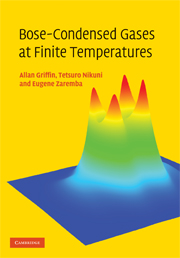Book contents
- Frontmatter
- Contents
- Preface
- 1 Overview and introduction
- 2 Condensate dynamics at T = 0
- 3 Coupled equations for the condensate and thermal cloud
- 4 Green's functions and self-energy approximations
- 5 The Beliaev and the time-dependent HFB approximations
- 6 Kadanoff–Baym derivation of the ZNG equations
- 7 Kinetic equation for Bogoliubov thermal excitations
- 8 Static thermal cloud approximation
- 9 Vortices and vortex lattices at finite temperatures
- 10 Dynamics at finite temperatures using the moment method
- 11 Numerical simulation of the ZNG equations
- 12 Simulation of collective modes at finite temperature
- 13 Landau damping in trapped Bose-condensed gases
- 14 Landau's theory of superfluidity
- 15 Two-fluid hydrodynamics in a dilute Bose gas
- 16 Variational formulation of the Landau two-fluid equations
- 17 The Landau–Khalatnikov two-fluid equations
- 18 Transport coefficients and relaxation times
- 19 General theory of damping of hydrodynamic modes
- Appendix A Monte Carlo calculation of collision rates
- Appendix B Evaluation of transport coefficients: technical details
- Appendix C Frequency-dependent transport coefficients
- Appendix D Derivation of hydrodynamic damping formula
- References
- Index
2 - Condensate dynamics at T = 0
Published online by Cambridge University Press: 06 October 2009
- Frontmatter
- Contents
- Preface
- 1 Overview and introduction
- 2 Condensate dynamics at T = 0
- 3 Coupled equations for the condensate and thermal cloud
- 4 Green's functions and self-energy approximations
- 5 The Beliaev and the time-dependent HFB approximations
- 6 Kadanoff–Baym derivation of the ZNG equations
- 7 Kinetic equation for Bogoliubov thermal excitations
- 8 Static thermal cloud approximation
- 9 Vortices and vortex lattices at finite temperatures
- 10 Dynamics at finite temperatures using the moment method
- 11 Numerical simulation of the ZNG equations
- 12 Simulation of collective modes at finite temperature
- 13 Landau damping in trapped Bose-condensed gases
- 14 Landau's theory of superfluidity
- 15 Two-fluid hydrodynamics in a dilute Bose gas
- 16 Variational formulation of the Landau two-fluid equations
- 17 The Landau–Khalatnikov two-fluid equations
- 18 Transport coefficients and relaxation times
- 19 General theory of damping of hydrodynamic modes
- Appendix A Monte Carlo calculation of collision rates
- Appendix B Evaluation of transport coefficients: technical details
- Appendix C Frequency-dependent transport coefficients
- Appendix D Derivation of hydrodynamic damping formula
- References
- Index
Summary
Trapped Bose-condensed atomic gases are remarkable because, in spite of the fact that these are very dilute systems, they exhibit robust coherent dynamic behaviour when perturbed. These quantum “wisps of matter” are a new phase of highly coherent matter. While binary collisions are very infrequent, the large coherent mean field associated with the Bose condensate ensures that interactions play a crucial role in determining the collective response of these trapped superfluid gases.
In our discussion of the theory of collective oscillations of atomic condensates, the macroscopic Bose wavefunction Φ(r, t) plays a central role. This wavefunction is the BEC order parameter. As discussed in Chapter 1, the initial attempts at defining this order parameter began with the pioneering work of London (1938a), were further developed by Bogoliubov (1947) and finally extended to deal with any Bose superfluid using the general quantum field theoretic formalism developed by Beliaev (1958a). Almost all this early theoretical work was limited to T = 0 where, in a dilute weakly interacting Bose gas, all the atoms are in the condensate. The first extension of these ideas to nonuniform Bose condensates was by Pitaevskii (1961) and, independently, by Gross (1961), which led to the now famous Gross–Pitaevskii (GP) equation of motion for Φ(r, t). Before the discovery of BEC in trapped gases, the time-dependent GP equation was mainly used to study vortices in Bose superfluids, which involve a spatially nonuniform ground state. Apart from this application, the GP equation was largely unknown. The situation changed overnight in 1995 with the creation of trapped nonuniform Bose condensates in atomic gases.
- Type
- Chapter
- Information
- Bose-Condensed Gases at Finite Temperatures , pp. 19 - 31Publisher: Cambridge University PressPrint publication year: 2009



